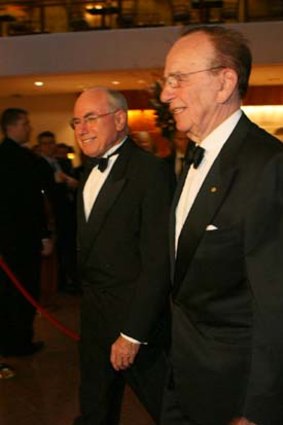By Tony Wright
Rupert Murdoch doesn't come to powerful politicians. They come to him.
Australian prime ministers have made such a habit of breaking bread with Murdoch in New York that it hardly rates a headline any more. Julia Gillard was walking a path well beaten by John Howard and Kevin Rudd when, on her first visit to New York as PM, she lunched with Murdoch in March.

Kevin Rudd and Rupert Murdoch after a meeting in 2007.
Such a trek, however, is a relatively recent requirement for prime ministers keen to establish favour with the world's most feared media proprietor.
Indeed, some politicians have had to learn to control their fear. When he was opposition leader in the late 1980s, John Howard was waiting in an ante-room at the Herald and Weekly Times offices, preparing for an audience with Murdoch. The deputy editor of The Herald at the time, Bruce Guthrie, recalled Howard was so nervous, the water in his glass splashed everywhere.

Rupert Murdoch and then Prime Minister John Howard in 2006.
Murdoch has long recognised the psychological advantage of bringing supplicants on to his own turf. Way back in the 1960s, as he laid plans to establish The Australian, Murdoch enlisted the help of a friend and mentor, the tough Country Party leader John McEwen, to help him find a property suitable for a fledgling media tycoon. Thus was born the Murdoch country seat within short driving distance of our national capital: Cavan, a splendid and historic grazing property near Yass.
According to John Menadue, the general manager of News Ltd for seven years from 1967, Murdoch once considered running for Country Party preselection.
''But as his power increased clearly he didn't have to defer to prime ministers and ask them for favours; he could be very influential, he believed, in deciding who should be the prime minister or the president,'' Menadue said of his old boss in a 2006 interview.
Senior politicians of all stripes have since made the journey to Cavan, where guests for years were expected to dress for dinner, the men retiring afterwards for cognac and cigars.
Governor-general Sir John Kerr made his way to Cavan in November, 1974. According to a biography of Murdoch by the journalist George Munster, the governor-general launched into a discussion about prime minister Gough Whitlam's looming problems, including the difficulty of getting supply through the Senate. Murdoch sat quietly, listening intently.
Precisely a year later, with supply duly stalled, Sir John sacked the Whitlam government. By then, Murdoch had switched from his earlier enthusiastic support of Whitlam.
So extreme was Murdoch's campaign against Whitlam in 1975 that his journalists went on strike and 75 of them wrote to Murdoch, describing their paper as ''a propaganda sheet''.
As the News media empire expanded, Cavan was merely the first of a number of luxurious lairs Murdoch would establish.
Apart from his $44 million New York apartment and a sumptuous home in St James, London, he has a huge ranch in the Carmel Valley, south of San Francisco. A few days before this year's federal budget, Murdoch flew some of his most senior Australian journalists and the boss of his Australian media group, John Hartigan, to the Carmel ranch, where they workshopped News Ltd's coverage of the Gillard government, scribbling thoughts on butcher's paper.
For many years Murdoch also maintained a townhouse at one of Canberra's best addresses, Wickham Crescent, Red Hill, just up the road from Parliament House. Prime ministers could also slip around to Wickham Crescent for a quiet chat.
Murdoch was not alone in this. The media baron Sir Warwick Fairfax had a mansion around the corner, where prime minister Robert Menzies was a frequent visitor in the 1960s. Later, the media tycoon Kerry Packer purchased a house nearby, using it as his lobbying headquarters when he was trying unsuccessfully to win control of the Fairfax empire (publisher of The Age). More recently, Kerry Stokes has hosted Kevin Rudd at his beach hideaway in Broome.
But Murdoch was the most enthusiastic entertainer of politicians in Canberra and district.
His touch paid off handsomely in 1985, when the Hawke government allowed him to fulfil his long-held desire to purchase the Herald and Weekly Times.
A decade later, in October 1995, prime minister Paul Keating was furious when reporters and photographers sprang him making what he thought was a secret visit to Murdoch's Wickham Crescent townhouse.
Five days later, Keating delivered his Creative Nation speech. Central to it was the announcement that Murdoch's 20th Century Fox would establish a film studio in Sydney.
The Keating visit says much about the complicated nature of Murdoch's relationship with politicians. There was something in it for Keating, who got to deliver a much-needed positive announcement, but there was more in it for Murdoch, who got a new site, heavily subsidised, for his movie interests.
Self-interest appears to have driven Murdoch's desire for political clout. Within a few months of entertaining Keating, he was supping with new prime minister John Howard, with cross-media regulations on the menu. And then there was Rudd. And now Gillard.
To Rupert Murdoch, only the names on the menu change.